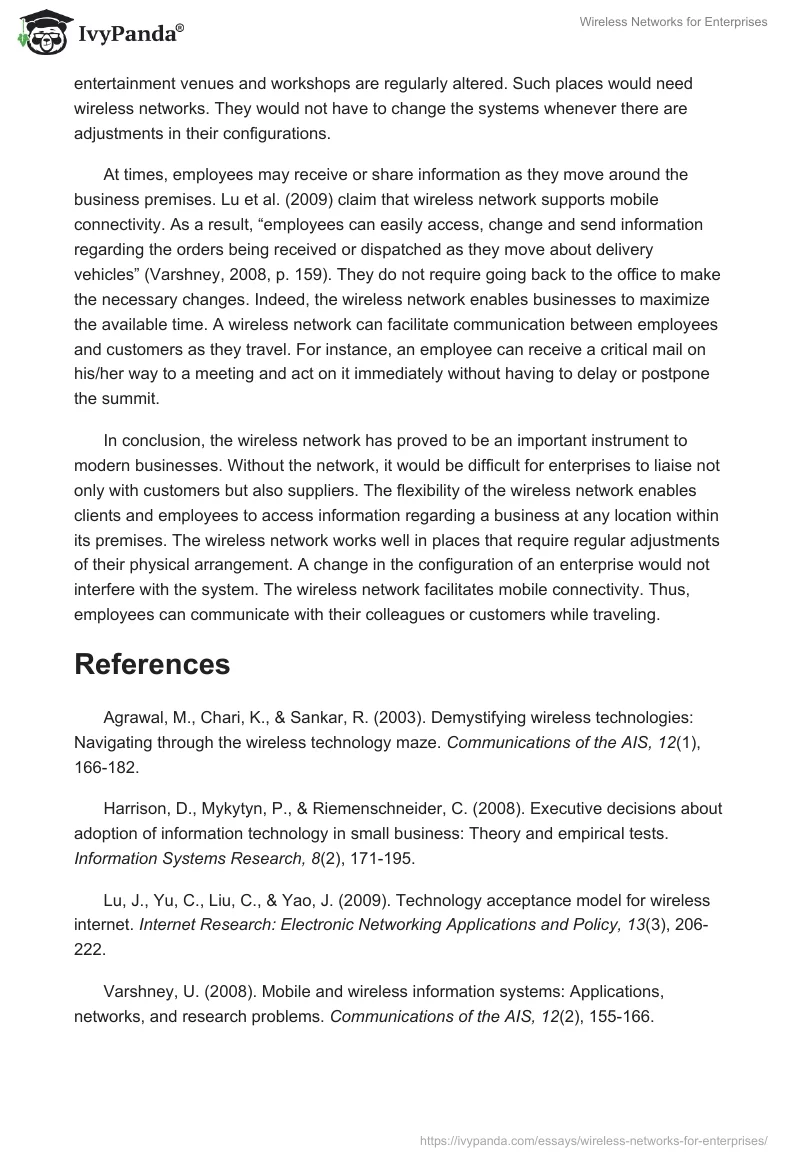Significance of Wireless Network to Enterprises
Technological advancement has resulted in the creation of numerous modes of communication. One most significant medium of communication is a wireless network. Agrawal, Chari, and Sankar (2003) claim, “A wireless network refers to a system of communication that uses radio waves to connect devices such as laptops to the internet and the business network and its applications” (p. 169). Communication is paramount to enterprises. It enables them to connect with customers, understand their needs and exploit them. The wireless network facilitates communication between businesspeople and clients. Agrawal et al. (2003) hold that wireless network has numerous qualities that can benefit enterprises. They include location flexibility, accessibility, and mobile connectivity. This essay will discuss these conditions and how they help businesses.
According to Harrison, Mykytyn, and Riemenschneider (2008), a wireless network can operate at any location. A wireless gadget can “connect at any location as long as it is within the range of a network” (Harrison et al., 2008, p. 177). In other words, it is convenient for businesses. As a firm grows, the management may be forced to reorganize the offices or workstations. In such a case, the company would not be compelled to make adjustments to the wireless network. Physical reorganization of the workplace would not interfere with connectivity. Employees would like to access information regarding an enterprise. The wireless network enables customers to use their gadgets to access information about the business at any location within its premises. For instance, they can connect to the enterprise’s network while waiting at reception.
Lu, Yu, Liu, and Yao (2009) claim that wireless network works in areas that are not apposite or hard to wire. In an industrial environment, it may be difficult to use a wired network to connect all the offices. Additionally, a wired network may be prone to damage. In such a case, an industry may opt to use a wireless network. The system is not prone to damage as it does not use wires. On the other hand, some businesses require changing their configuration frequently. For instance, the arrangements of entertainment venues and workshops are regularly altered. Such places would need wireless networks. They would not have to change the systems whenever there are adjustments in their configurations.
At times, employees may receive or share information as they move around the business premises. Lu et al. (2009) claim that wireless network supports mobile connectivity. As a result, “employees can easily access, change and send information regarding the orders being received or dispatched as they move about delivery vehicles” (Varshney, 2008, p. 159). They do not require going back to the office to make the necessary changes. Indeed, the wireless network enables businesses to maximize the available time. A wireless network can facilitate communication between employees and customers as they travel. For instance, an employee can receive a critical mail on his/her way to a meeting and act on it immediately without having to delay or postpone the summit.
In conclusion, the wireless network has proved to be an important instrument to modern businesses. Without the network, it would be difficult for enterprises to liaise not only with customers but also suppliers. The flexibility of the wireless network enables clients and employees to access information regarding a business at any location within its premises. The wireless network works well in places that require regular adjustments of their physical arrangement. A change in the configuration of an enterprise would not interfere with the system. The wireless network facilitates mobile connectivity. Thus, employees can communicate with their colleagues or customers while traveling.
References
Agrawal, M., Chari, K., & Sankar, R. (2003). Demystifying wireless technologies: Navigating through the wireless technology maze. Communications of the AIS, 12(1), 166-182.
Harrison, D., Mykytyn, P., & Riemenschneider, C. (2008). Executive decisions about adoption of information technology in small business: Theory and empirical tests. Information Systems Research, 8(2), 171-195.
Lu, J., Yu, C., Liu, C., & Yao, J. (2009). Technology acceptance model for wireless internet. Internet Research: Electronic Networking Applications and Policy, 13(3), 206-222.
Varshney, U. (2008). Mobile and wireless information systems: Applications, networks, and research problems. Communications of the AIS, 12(2), 155-166.


